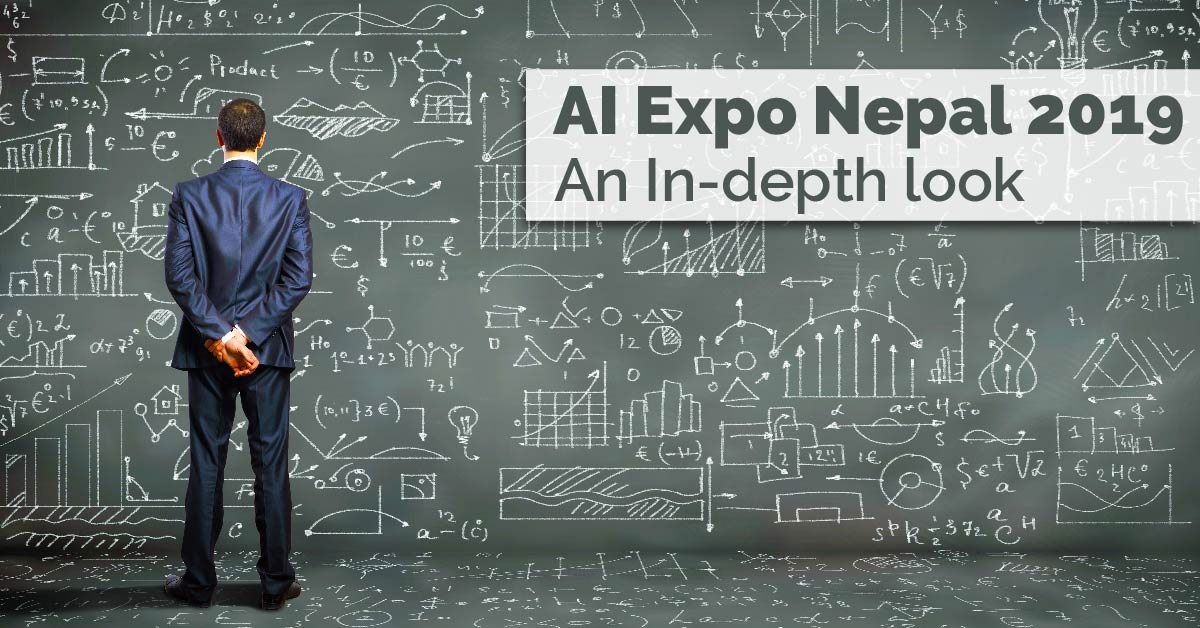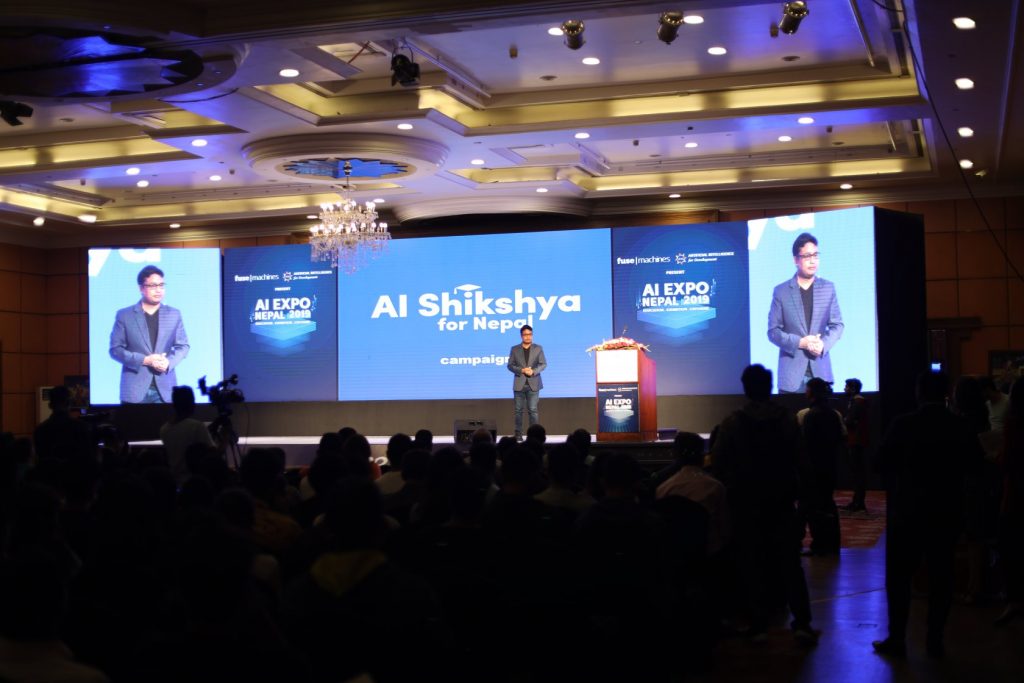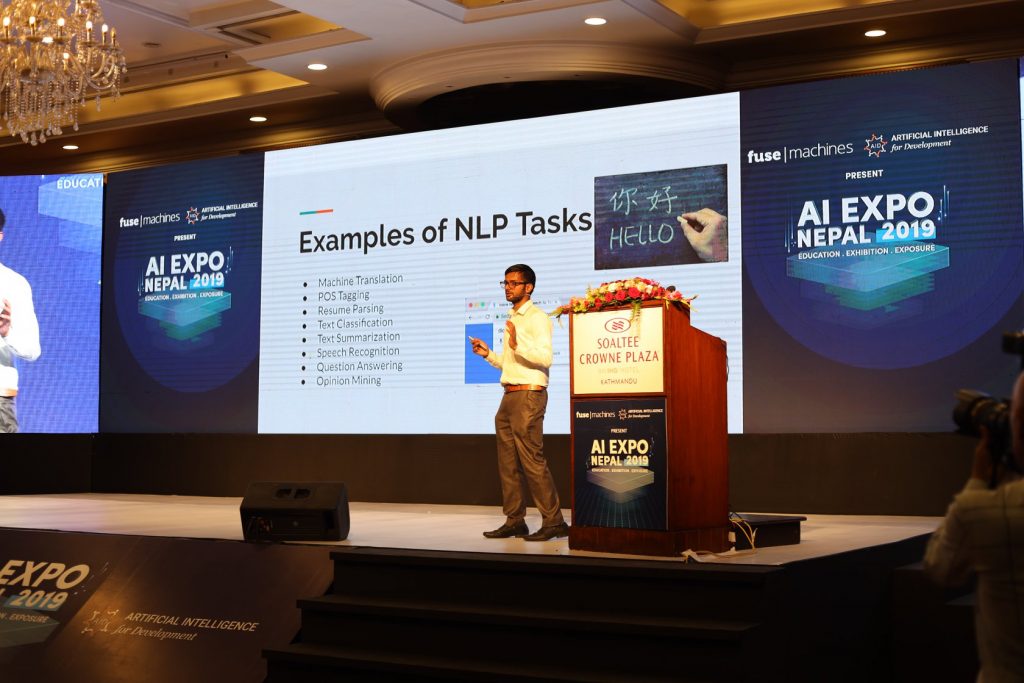
Nepal’s first and biggest AI Expo happened on August 24th, 2019 at Soaltee Crowne Plaza. AI Expo Nepal 2019, a joint initiation by Fusemachines and Artificial Intelligence for Development (AID) aimed to showcase the best AI projects/papers from academia and industry. More than 2000 people attended the event which came to as a surprise and marked a significant period in history. The expo featured about 20 projects from academia and industries with each project focused on interesting use cases.
The event commenced with a keynote address from Dr. Sameer Maskey, Founder and CEO of Fusemachines where he talked about democratizing AI and officially announced his campaign ‘AI Shikshya for Nepal’ which aims to empower students, AI engineers and researchers all over Nepal. The event followed up with two plenary discussions consisting of panelists and moderators sharing their thoughts on integrating AI and AI for national development which then followed up with an address by Chief Guest Minister of Education, Science, and Technology Giriraj Mani Pokharel and then followed by learning sessions on AI.

The plenary discussions highlighted major concerns, shortcomings, challenges, plans, and policies concerning AI in Nepal. The discussions pointed out a major design flaw in existing systems in the government sector where the systems are fragmented and lack integration among other systems. The discussion also helped shed some light on the need for policies on data and security.
In ‘Learning Sessions’ senior engineers from Fusemachines and AID presented attendees with key concepts on Machine Learning, Deep Learning, Computer Vision and Natural Language Processing. In case anyone missed the event, AI Expo Nepal has listed a range of learning resources where one can teach themselves and sharpen their skills in AI.
The exhibition stalls were the main center of attraction about this expo as it featured some interesting projects and added a new perspective on intelligent systems and its application areas. The 20 projects featured in this expo is actually the condensed version. The selection, elimination, and mentoring projects from idea and prototype to a minimum viable product lasted for about 3 months prior to the main event, the AI Expo. Here I’ll discuss some of the projects featured in the expo based on my interaction with teams:
Attendance with Facial Recognition
This project identifies students in a classroom and takes attendance recognizing their faces via CCTV cameras. The algorithm recognizes faces on certain predefined intervals based on which it sets attendance as present in class. The technology they used for this project is TensorFlow library with machine learning models such as SSD (Single Shot Multibox Detector): used for object detection and FaceNet: used for facial recognition.
For this application to identify faces it needs an image source of students as a dataset and trains the algorithm based on the classified data. As the number of students will vary, the data collection and training of the algorithm might take a significant amount of time. Also, the quality of the CCTV camera plays a vital role in the performance of the algorithm to correctly identify faces, the same with the latency due to internet speed. Based on their demo footage, their application detected facial geometry but not the person in the face, upon which they added the feature could be integrated in the future.
Learn about SSD and FaceNet here:
Building a face recognition system with FaceNet
Understand Single Shot MultiBox Detector (SSD) and Implement It in Pytorch
Tensorflow Face Detector
Prevention Road Kill
The main purpose of this project is to detect objects and track lane in a highway and prevent a car from a collision. This project makes use of deep learning algorithm such as Convolutional Neural Networks (ConvNet/CNN) to detect objects from video frames and prevent collision.
The limiting factor for this project is it requires a lot of training data and based on their presentation it seemed the project needed a lot of work to be done.
Learn about ConvNet here:
Deep-dive into Convolutional Networks
Savior of the Heart
This project is a desktop application that takes various input parameters from the user and predicts their risk score of having any heart-related diseases within a 10 years’ time interval along with health status of the heart with prevention measures based on their status. This project uses a machine learning model such as Random Forest Regression and SVM Regression.
As promising this project sounds, this could be a good fit for clinical labs and hospitals as they have a wide range of data from patients. As this application deals with critical data, the result it predicts is critical too. If this results in too many false positives then this could have a major impact on the patient’s psychology. This concern was acknowledged by the team and they stressed the fact that for this application to perform well it needs to be trained on health data from Nepal.
Learn about Random Forest Regression and SVM Regression here:
Random Forest Regression
Understanding Support Vector Machine Regression
Essay Grader
This application auto grades human written essays based on the number of datasets, i.e. a wide variety of essays it’s trained with. The project is based on Natural Language Processing (NLP), a subfield of AI concerned with interactions between computers and human languages.

According to the team, this model can help grade essays in standardized tests like IELTS writing test and GRE. Moreover, it can also be used to grade essay written by students in school which could save a lot of time for teachers. There are some limitations though, the model is not well trained as it lacks actual academic datasets and the results might be biased, in case, if the sample assays for training were marked inconsistently. They acknowledged the model is not perfectly ready to score essay better than humans but it does give a sense where the essay score stands in a range of 0 to 12.
Learn about NLP here:
Your Guide to Natural Language Processing (NLP)
Music Generation with Nepali music
This project aimed to generate polyphonic music from a model trained on Nepali music. The model was based on Long Short-Term Memory (LSTM); a Recurrent Neural Network (RNN) architecture.
The primary objectives are:
– Inspiration for aspiring composers.
– No Copyright Music for use in YouTube videos.
The team explained they learned about music theory, explored restricted Boltzmann machines, LSTM based networks, simple Markov models and experimented with LSTM model with attention for polyphonic music generation.
Based on their demo, the application was able to generate music but the melody was just a random one based on a diatonic scale that lacked motif and context. Overall, it was a decent effort.
Learn about LSTMs here:
A Beginner’s Guide to LSTMs and Recurrent Neural Networks
Real-Time Vehicle Tracking and Recognition (RTVTR)
This prototype was developed by Inspiring Lab Pvt. Ltd., an AI startup. RTVTR is a computer vision application that recognizes characters in Nepali number plates. Initially, an image frame is captured from a CCTV camera and passed through a prediction model to extract the region from the frame consisting of a license plate. This plate image is then passed through an Optical Character Recognition (OCR) model for prediction of Nepali characters. Additional features include recognition of different types of vehicles, vehicle count, flagging and identifying specified vehicles and detection analytics.
According to the team, the purpose of developing this system was aimed towards solving traffic congestion and surveillance, parking system and time card management, as well as toll booth collection problems prevalent in the urban landscape of Nepal.
Learn about computer vision and OCR here:
A Gentle Introduction to Computer Vision
A Gentle Introduction to OCR
Winners of the AI Expo Nepal 2019
Based on the selection criteria, out of 20 projects, three winning projects were selected:
- Real-Time Vehicle Tracking and Recognition (RTVTR)
- GhumGham
- Polyphonic Music Generation with RNN

The event ended with closing remarks by Mr. Kshitiz Rimal, Head of Research at AID, and Photo Session.
Conclusion
This expo proved that there are AI talents here among us waiting for the opportunity to showcase their skills. The participating teams also highlighted a major limitation which hindered their projects due to lack of availability of local datasets, as a result, they had to rely on sample datasets from the internet. As AI is built on top of data, the more data is fed to the algorithm, the better the performance. Also, the overwhelming number of 2000+ attendees showed that people are interested in AI and want to learn more about it and embrace change. The plenary discussions showed that government needs to step up and embrace change as well and integrate their available infrastructure with modern technology, scalable architecture and artificial intelligence.















![Best Ultrabooks To Buy in Nepal 2024 [Updated] Best Ultrabook Laptops in Nepal 2023 - June Update](https://cdn.gadgetbytenepal.com/wp-content/uploads/2023/04/Best-Ultrabook-Laptops-in-Nepal-2023-June-Update.jpg)
![Best Gaming Laptops in Nepal 2024 [Updated] Best Gaming Laptops in Nepal 2023 - June Update](https://cdn.gadgetbytenepal.com/wp-content/uploads/2023/04/Best-Gaming-Laptops-in-Nepal-2023-June-Update.jpg)



![Best Mobile Phones Under Rs. 15,000 in Nepal [Updated] Best Phones Under 15000 in Nepal 2024 Budget Smartphones Cheap Affordable](https://cdn.gadgetbytenepal.com/wp-content/uploads/2024/03/Best-Phones-Under-15000-in-Nepal-2024.jpg)
![Best Mobile Phones Under Rs. 20,000 in Nepal [Updated] Best Mobile Phones Under NPR 20000 in Nepal 2023 Updated Samsung Xiaomi Redmi POCO Realme Narzo Benco](https://cdn.gadgetbytenepal.com/wp-content/uploads/2024/01/Best-Phones-Under-20000-in-Nepal-2024.jpg)
![Best Mobile Phones Under Rs. 30,000 in Nepal [Updated]](https://cdn.gadgetbytenepal.com/wp-content/uploads/2023/12/Best-Phones-Under-30000-in-Nepal-2024.jpg)
![Best Mobile Phones Under Rs. 40,000 in Nepal [Updated] Best Phones Under 40000 in Nepal 2024 Smartphones Mobile Midrange](https://cdn.gadgetbytenepal.com/wp-content/uploads/2024/02/Best-Phones-Under-40000-in-Nepal-2024.jpg)
![Best Mobile Phones Under Rs. 50,000 in Nepal [Updated] Best Phones Under 50000 in Nepal 2024 Smartphones Midrange](https://cdn.gadgetbytenepal.com/wp-content/uploads/2024/02/Best-Phones-Under-50000-in-Nepal-2024.jpg)
![Best Flagship Smartphones To Buy In Nepal [Updated] Best Smartphones in Nepal 2024 Flagship Premium Samsung Apple iPhone Xiaomi OnePlus Honor](https://cdn.gadgetbytenepal.com/wp-content/uploads/2023/09/Best-Smartphones-in-Nepal-2024.jpg)